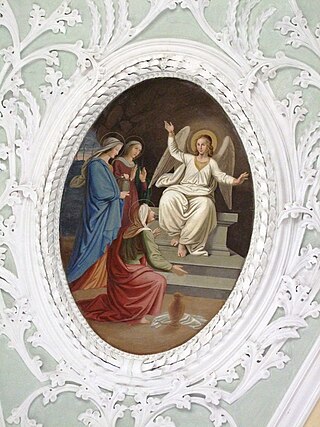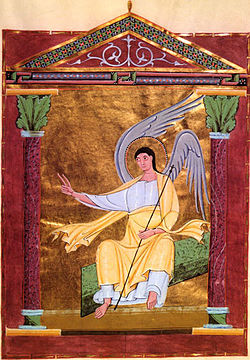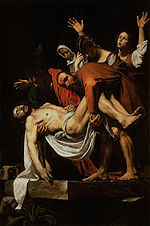
The Gospel of Mark is the second of the four canonical gospels and one of the three synoptic Gospels. It tells of the ministry of Jesus from his baptism by John the Baptist to his death, the burial of his body, and the discovery of his empty tomb. It portrays Jesus as a teacher, an exorcist, a healer, and a miracle worker, though it does not mention a miraculous birth or divine pre-existence. He refers to himself as the Son of Man. He is called the Son of God but keeps his messianic nature secret; even his disciples fail to understand him. All this is in keeping with the Christian interpretation of prophecy, which is believed to foretell the fate of the messiah as suffering servant.

The Gospel of Matthew is the first book of the New Testament of the Bible and one of the three synoptic Gospels. It tells how Israel's Messiah, Jesus, comes to his people but is rejected by them and how, after his resurrection, he sends the disciples to the gentiles instead. Matthew wishes to emphasize that the Jewish tradition should not be lost in a church that was increasingly becoming gentile. The gospel reflects the struggles and conflicts between the evangelist's community and the other Jews, particularly with its sharp criticism of the scribes and Pharisees with the position that through their rejection of Christ, the Kingdom of God has been taken away from them and given instead to the church.
Gospel originally meant the Christian message, but in the 2nd century it came to be used also for the books in which the message was reported. In this sense a gospel can be defined as a loose-knit, episodic narrative of the words and deeds of Jesus, culminating in his trial and death and concluding with various reports of his post-resurrection appearances. Modern biblical scholars are cautious of relying on the gospels uncritically, but nevertheless, they provide a good idea of the public career of Jesus, and critical study can attempt to distinguish the original ideas of Jesus from those of the later Christian authors.

Mary Magdalene was a woman who, according to the four canonical gospels, traveled with Jesus as one of his followers and was a witness to his crucifixion and resurrection. She is mentioned by name twelve times in the canonical gospels, more than most of the apostles and more than any other woman in the gospels, other than Jesus's family. Mary's epithet Magdalene may be a toponymic surname, meaning that she came from the town of Magdala, a fishing town on the western shore of the Sea of Galilee in Roman Judea.

The resurrection of Jesus is the Christian belief that God raised Jesus from the dead on the third day after his crucifixion, starting – or restoring – his exalted life as Christ and Lord. According to the New Testament writing, Jesus was firstborn from the dead, ushering in the Kingdom of God. He appeared to his disciples, calling the apostles to the Great Commission of forgiving sin and baptizing repenters, and ascended to Heaven.

Mark 16 is the final chapter of the Gospel of Mark in the New Testament of the Christian Bible. Christopher Tuckett refers to it as a "sequel to the story of Jesus' death and burial". The chapter begins after the sabbath has ended, with Mary Magdalene, Mary the mother of James, and Salome purchasing spices to bring to the tomb next morning to anoint Jesus' body. There they encounter the stone rolled away, the tomb open, and a young man dressed in white who announces the resurrection of Jesus. The two oldest manuscripts of Mark 16 conclude with verse 8, which ends with the women fleeing from the empty tomb, and saying "nothing to anyone, because they were too frightened".

Jesus, also referred to as Jesus Christ, Jesus of Nazareth, and many other names and titles, was a first-century Jewish preacher and religious leader. He is the central figure of Christianity, the world's largest religion. Most Christians believe Jesus to be the incarnation of God the Son and the awaited messiah, the Christ that is prophesied in the Old Testament.

The life of Jesus is primarily outlined in the four canonical gospels, which includes his genealogy and nativity, public ministry, passion, prophecy, resurrection and ascension. Other parts of the New Testament – such as the Pauline epistles which were likely written within 20 to 30 years of each other, and which include references to key episodes in the life of Jesus, such as the Last Supper, and the Acts of the Apostles, which includes more references to the Ascension episode than the canonical gospels also expound upon the life of Jesus. In addition to these biblical texts, there are extra-biblical texts that Christians believe make reference to certain events in the life of Jesus, such as Josephus on Jesus and Tacitus on Christ.
John 20 is the twentieth chapter of the Gospel of John in the New Testament. It relates the story of Jesus' resurrection. It relates how Mary Magdalene went to the tomb of Jesus and found it empty. Jesus appears to her and speaks of his resurrection and dispatches Mary to tell the news to the disciples. Jesus then appears to his disciples. The events related in John 20 are described somewhat differently in Matthew 28, Mark 16, and Luke 24.

John 20:18 is the eighteenth verse of the twentieth chapter of the Gospel of John in the New Testament. It occurs after Jesus' resurrection and appearance to Mary Magdalene. In the previous verse Jesus has given Mary a message to deliver to his disciples, this verse describes how she delivers it.

The stolen body hypothesis posits that the body of Jesus Christ was stolen from his burial place. It theorises that his tomb was found empty not because he was resurrected, but because the body had been hidden somewhere else by the apostles or unknown persons. Both the stolen body hypothesis and the debate over it presume the basic historicity of the gospel accounts of the tomb discovery. The stolen body hypothesis finds the idea that the body was not in the tomb plausible – such a claim could be checked if early Christians made it – but considers it more likely that early Christians had been misled into believing the resurrection by the theft of Jesus's body.

Matthew 28 is the twenty-eighth and final chapter of the Gospel of Matthew in the New Testament. This chapter records that Jesus is risen, describes the actions of the first witnesses to this event, and ends with the Great Commission.

Luke 24 is the twenty-fourth and final chapter of the Gospel of Luke in the New Testament of the Christian Bible. The book containing this chapter is anonymous, but early Christian tradition uniformly affirmed that Luke the Evangelist composed this Gospel as well as the Acts of the Apostles. This chapter records the discovery of the resurrection of Jesus Christ, his appearances to his disciples and his ascension into heaven.

Matthew 28:7 is the seventh verse of the twenty-eighth chapter of the Gospel of Matthew in the New Testament. This verse is part of the resurrection narrative. An angel has appeared at the empty tomb and in this verse he continues his instructions to Mary Magdalene and "the other Mary".

Matthew 28:10 is the tenth verse of the twenty-eighth chapter in the Gospel of Matthew in the New Testament. This verse is part of the resurrection narrative. Having left the empty tomb, Mary Magdalene and "the other Mary" are on their way to meet the other disciples, when Jesus meets with them. In this verse the risen Jesus speaks with them.

Matthew 27:55–56 are the fifty-sixth and fifty-seventh verses of the twenty-seventh chapter of the Gospel of Matthew in the New Testament. The crucifixion and death of Jesus have just occurred, and these verses make note of a group of women who were present at that event.

The Three Marys are women mentioned in the canonical gospels' narratives of the crucifixion and resurrection of Jesus. Mary was the most common name for Jewish women of the period.

In Eastern Orthodox Christian tradition the Myrrhbearers are the individuals mentioned in the New Testament who were directly involved in the burial or who discovered the empty tomb following the resurrection of Jesus. The term traditionally refers to the women who came with myrrh to the tomb of Christ early in the morning to find it empty. Also included are Joseph of Arimathea and Nicodemus, who took the body of Jesus down from the cross, anointed it with myrrh and aloes, wrapped it in clean linen, and placed it in a new tomb. In Western Christianity, the women at the tomb, the Three Marys or other variants are the terms normally used.

The burial of Jesus refers to the entombment of the body of Jesus after his crucifixion before the eve of the sabbath. This event is described in the New Testament. According to the canonical gospel narratives, he was placed in a tomb by a councillor of the Sanhedrin named Joseph of Arimathea; according to Acts 13:28–29, he was laid in a tomb by "the council as a whole". In art, it is often called the Entombment of Christ.
Scholars have given various interpretations of the elements of the Gospel stories.

















